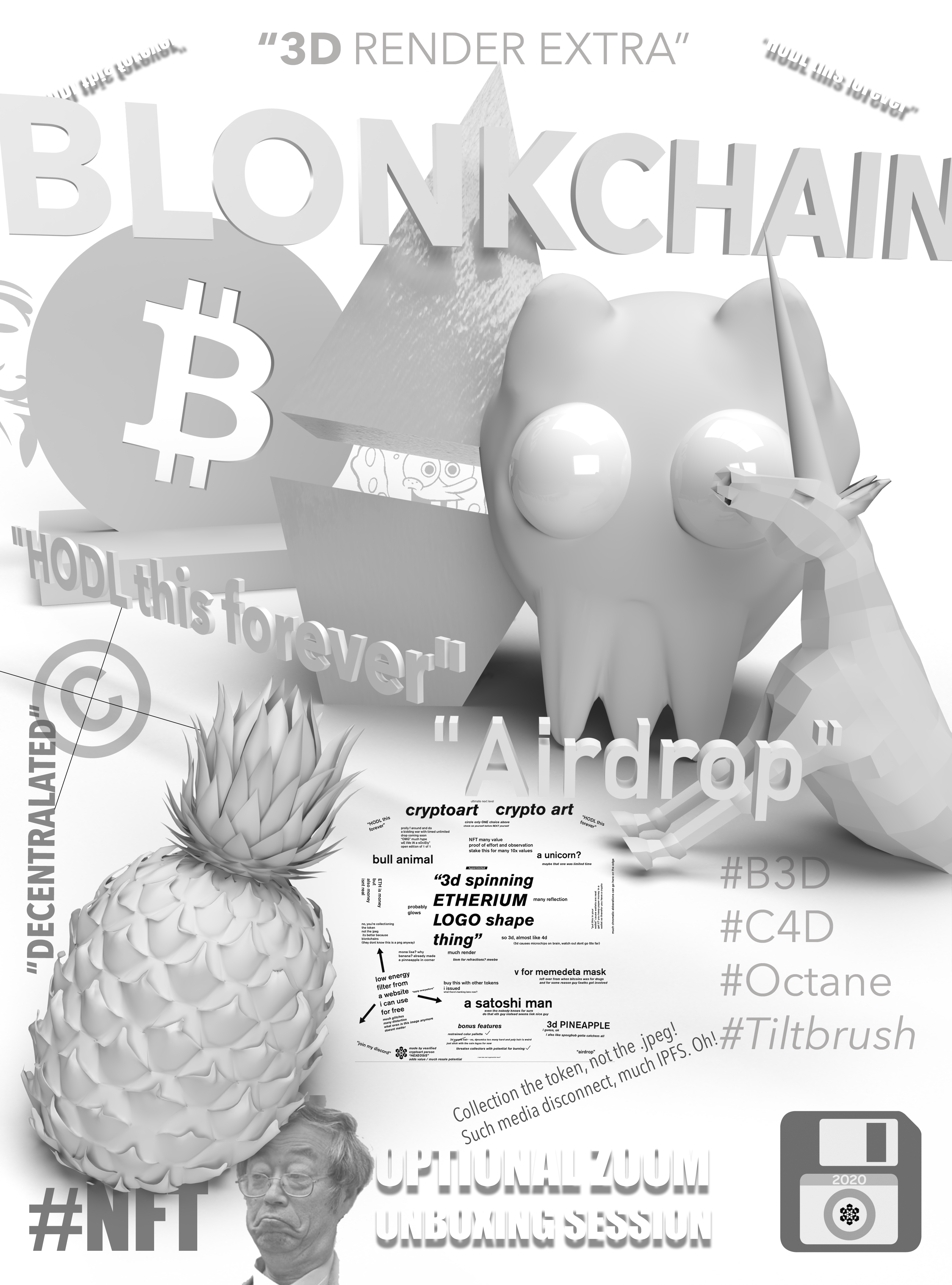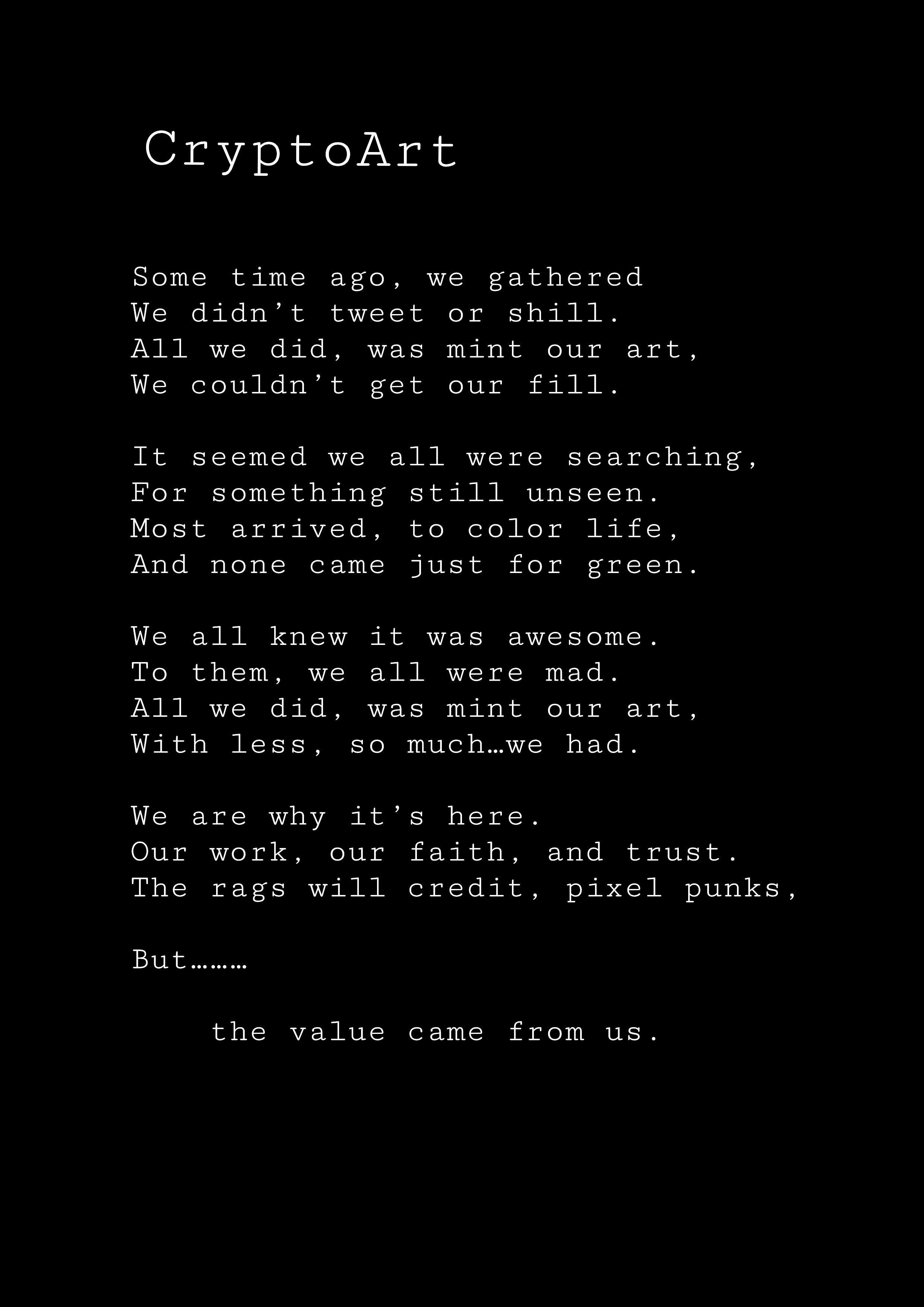
Above: Vitalik as a Cryptoartist (Suryanto sur, 2020) on SuperRare
A brief history of cryptoart
NFTs have an image problem. How do we correct that? Language is the key. Though web3 loyalists and early adopters are convinced of NFTs’ future economic, technological, and social potential, naysayers decry NFTs as worthless bits of digital trash with no clear value or purpose. Critics of this new technology cite the turbulent market, the widespread saturation of PFPs and collectibles, and skepticism on blockchain technology from traditional financial markets as proof of their claims that “NFTs are dead.” To critics, NFTs are just a passing fad–a brick in the wall of obsolete technologies. But this writer takes a different angle. Yes, NFTs are dead! But not in the way outlined by critics.“NFTs” are only the first iteration of a new technology. “NFT” is a useful term to explain the technology that powers art on the blockchain, but it does not embody the future of the movement from an artistic perspective. Artists, collectors, and industry professionals have gravitated towards a different term: cryptoart.
Some may see the use of different terminology to describe NFTs as a simple rebrand. But the two are different in more than just name. NFTs include any unique digital asset that can be collected and transferred on-chain from one user to another. This encompasses everything from CryptoPunks to POAPs (Proof of Attendance Protocols). There is no specification on what form these tokens have to take, but the most popular and well known form is that of cryptoart. One is the method, one is the thing itself. It is the difference between calling an Old Master painting an “oil” versus calling it a Rembrandt. Cryptoart is better suited to the works emerging from the fine art offerings of the NFT world, because it touches on the movement of provenance and individual ownership within the larger decentralized network. It pays homage to the NFTs that form its foundation, while acknowledging that art is the thing that is ultimately being created.
This new industry has so much talent: artists, thinkers, and web developers alike who take advantage of web3’s new sense of agency, set of creative and technological tools, and resultant mediums. Cryptoart, as a name, pays homage to the technology used to create it, as well as the body of work being created. But what is a crypto artist? In essence, they are artists who mint their work on the blockchain. Where they differ from traditional artists is in the underlying NFT technology, which is used to protect artists’ works and to enable their financial security. But the necessity to create art has not changed. Thus, this emergent world deserves a moniker that puts artists in sharp focus, because it is their work that is being bought, sold, cherished and championed. And indeed, there are artists of all ilks populating this new space: graphic designers, photographers, animators, musicians, and poets; all emboldened by the ability to set their own terms.
During the meteoric rise of NFTs, other forms of NFT projects, like CryptoPunks and CryptoKitties, predated the cryptoart movement. The market for PFPs, collectibles, utility-driven tokens, scams, and financial quick-flips grew far faster than the market for art. As a result, prices rose to astronomical heights, and these NFT projects not only stole the media spotlight from crypto artists, but also skewed public opinion of NFTs more generally toward hate and distrust. Now the market has plummeted into a crypto winter, with Bitcoin and Ethereum values dropping to record lows for the first time since 2020; a stark reminder of the risks of creating artwork tied to a new and volatile technology. This recent crash coincided with a new onslaught of people redoubling their belief that this nascent industry is doomed to fail.
Though the financial slump has been hard on artists, it represents a wider opportunity. Like a wildfire clears overgrowth, the crypto winter also burns away those same overvalued projects that so negatively shaped public opinion. The upended market provides fertile ground for a new cache of artists using the blockchain to their advantage, and allows cryptoart to once again take center stage. As artists in this new world have changed the norms surrounding transparency in compensation and recognition, so too have they changed the way we address them and the things they create. NFTs may be derided in the public eye, but cryptoart has the opportunity to define itself. The upheaval of the status quo reminds one of the dawn of the era of Enlightenment. During the Medieval period, art in Europe was largely religious and paid for by the Church. In the era directly following, experimental and, to some, blasphemous thought exploded. The result was one of the most fruitful periods for scientific and philosophical growth in human history. We may now be experiencing the same.
Not only is the foundational structure of this new artistic ecosystem vastly different from its physical predecessor, but also the diversity and breadth of emergent work. The umbrella of cryptoart covers artistic mediums as varied as its creators. In the same marketplace you can find cyberpunk cityscapes made by Turkish nineteen year old Idil Dursun, alongside graffiti-like offerings from celebrated American painter Cy Twombly. Cryptoart doesn’t denote one particular format, but instead encapsulates many mediums. This includes, but is not limited to: 3D and 2D animation, still photography, generative art, and a mixture of physical and digital practices. Styles are as manifold as the mediums they’re represented in. Cyberpunk, Trash Art, Impressionism, surreal and photorealistic pieces can all be termed cryptoart, as long as they’re minted on-chain. Cryptoart is creativity unbridaled by the limits of form.
Additionally, Cryptoart differs from its physical predecessors in its freedom from the limits of location. It is the first truly global art movement, not tethered by the confines of geography, nor centered on the European voices that have dominated the art market for centuries. Calli Mirales, a SuperRare gallerist with experience in both traditional art and cryptoart, spoke to the difference she noted between the traditional art world and cryptoart: “Cryptoart completely eradicates those locational and temporal boundaries, for the first time we are seeing an art movement happening simultaneously in a completely global capacity. Artists and collectors from all over the world can be instantly connected, totally reimagining the idea of community and exponentially expanding the bounds of creativity.” No other artistic movement has as wide a reach or as manifold a form.
The shift from NFTs to cryptoart is fecund with opportunity. We already live in a vastly digital world, but its shape is in the hands of the few, not the many. With the immutable qualities of the blockchain, artists now can protect their work from fraud and ensure they are duly compensated from each individual sale. NFTs have allowed a multitude of voices and visual styles to explode and be seen by people the world over. Once dominated by PFPs, collectibles, utility-driven tokens, and pump and dump schemes, the NFT market is now evolving into one that celebrates the artists and creators that exist at its core. With the movement to cryptoart, we have the opportunity to plant the seeds of a new narrative. Rather than be defined by the perceptions of the outside world, we use the language at our disposal to show off the NFT community we know to be true: a community founded on transparency and radical inclusivity. One founded on celebrating and supporting artists, collecting works that speak to your heart over your wallet, and building a better, more accessible and egalitarian career trajectory for artists as a whole.
To honor this new revolution–simultaneously a cultural, financial, and artistic one–we must use the correct language. Cryptoart is a more accurate name, and separates the chisel of NFTs from the newly sculpted work of cryptoart. It also allows for growth and specialization under the NFT umbrella. Perhaps we may soon be using terms like CryptoMusic, CryptoArchitecture, and CryptoPoetry to draw attention to the diverse masses of talent populating this brave new world. The time has come to evolve past our roots into our newest iteration and to breathe new life into web3 creativity: NFTs are dead, welcome to cryptoart!
Arianne Lapidus is a writer living and working in New York City. She has worked in several artistic mediums, from costume to graphic design. Arianne is a new entrant to the world of Web3 but finds that it aligns perfectly with her fixation on the intersection of technology, artistry, and design. You can find her musings on Web3 on Twitter: @arianne_tweets.
Art

Curated Conversations: ALIENQUEEN
SuperRare Labs Senior Curator An interviews ALIENQUEEN about psychedelics, death, and her journey in the NFT space.
Tech


Out of the Vault and onto the Chain: the Evolving Nature of Provenance
SuperRare editor Oli Scialdone considers the social experience of provenance and its relationship with community in the Web3 space.
Curators' Choice



Curated Conversations: ALIENQUEEN
SuperRare Labs Senior Curator An interviews ALIENQUEEN about psychedelics, death, and her journey in the NFT space.




